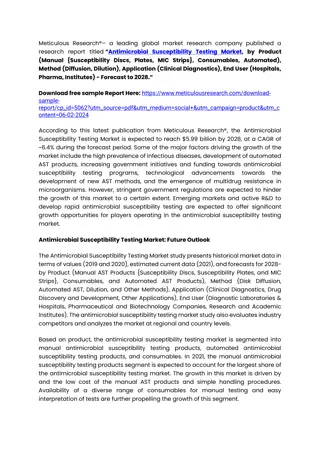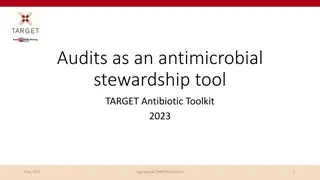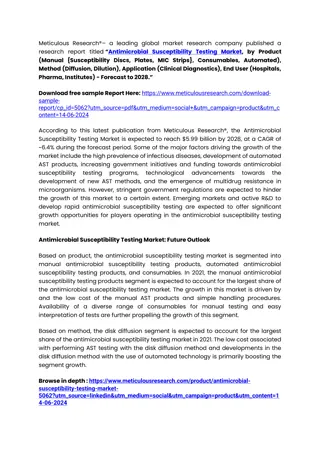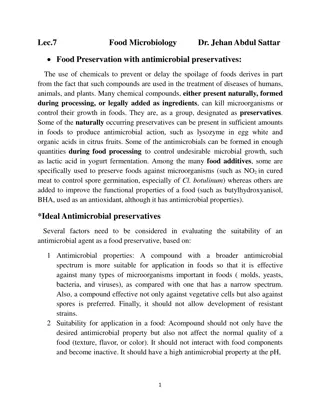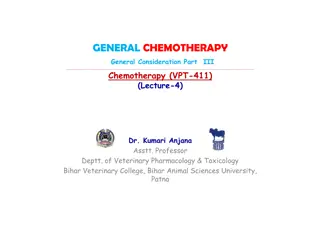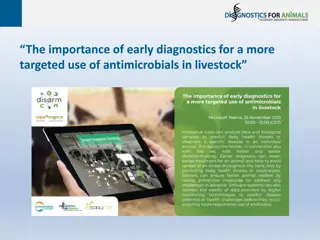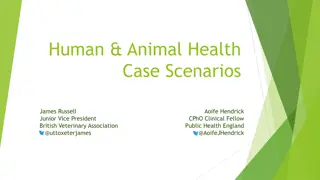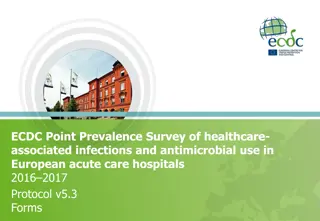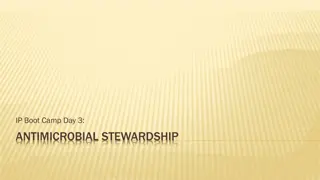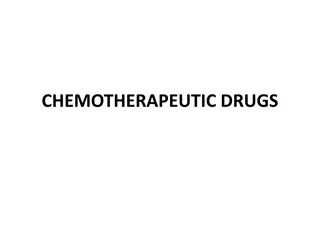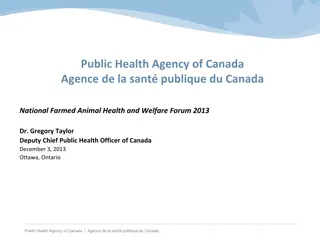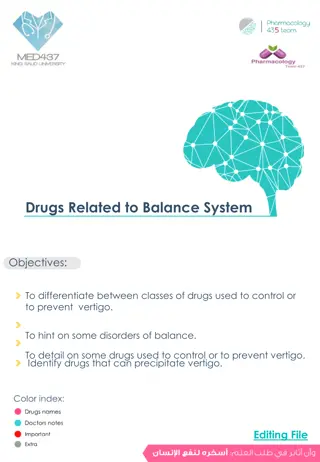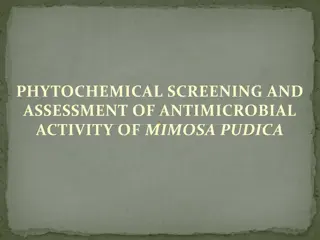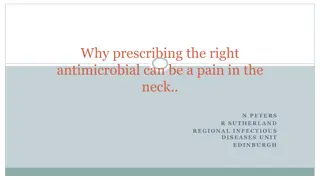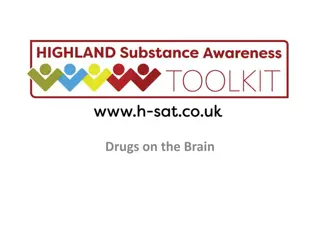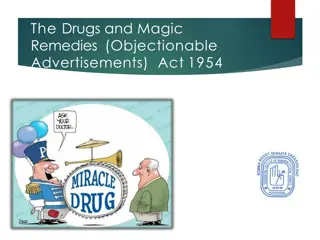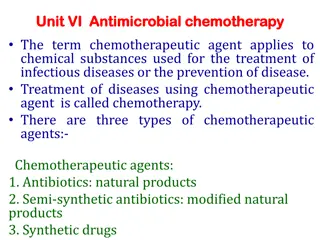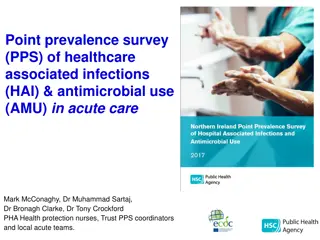Antimicrobial Susceptibility Testing Market
Antimicrobial susceptibility testing (AST) is a laboratory procedure to identify the right antimicrobial regimen against microbes. Thus, AST of the causative agent(s) is essential for the timely selection of appropriate antimicrobial therapy.
2 views • 3 slides
Utilizing Audits for Antimicrobial Stewardship in General Practice
The importance of audits in antimicrobial stewardship is highlighted in this informative content covering topics like why audit and feedback are crucial, sources of prescribing data, available audit tools, practical tips, and a case study showcasing the positive impact of audits in UTI management. T
10 views • 40 slides
Antimicrobial Coatings Market: Exploring Sustainable Approaches to Microbial Con
The Antimicrobial Coatings Market is projected to reach $12.41 billion by 2031, at a CAGR of 10.8% from 2024 to 2031. The antimicrobial coatings help to keep surfaces pathogen-free by obstructing the growth of fungi, bacteria, and other parasites. Antimicrobial coatings provide long-lasting protecti
3 views • 4 slides
Antimicrobial Susceptibility Testing Market
Government initiatives for combating multidrug resistance are expected to boost the need for antimicrobial susceptibility testing products, thereby driving the growth of the global antimicrobial susceptibility testing market.
1 views • 2 slides
Occupational Exposure to Hazardous Drugs: Risks and Prevention
Learn about the hazards of exposure to hazardous drugs, including potential health risks such as cancer, nausea, reproductive toxicity, and organ damage. Explore training modules, drug categories, and a list of hazardous drugs to ensure workplace safety. Discover NIOSH criteria for identifying hazar
1 views • 42 slides
Overview of Drugs and Cosmetics Act, 1940
The Drugs and Cosmetics Act of 1940 was enacted to regulate the import, manufacture, distribution, and sale of drugs and cosmetics in India. The Act aims to ensure high standards of medical treatment, prevent substandard drugs, and establish advisory boards for different types of drugs. It sets out
0 views • 49 slides
Sources of Crude Drugs: Plant, Animal, Marine, and Tissue Culture in Pharmacognosy
Crude drugs are natural substances obtained from plants, animals, and minerals. They are used without much processing and have therapeutic properties. Different plant parts like leaves, flowers, fruits, seeds, roots, bark, and stems yield various important drugs. Animals and minerals also serve as s
2 views • 19 slides
Food Preservation with Antimicrobial Preservatives
Food preservation with antimicrobial preservatives involves the use of chemical compounds to prevent or delay food spoilage. These compounds, either naturally present or added during processing, can kill microorganisms or control their growth in foods. Factors for evaluating the suitability of an an
6 views • 8 slides
The Drugs and Magic Remedies (Objectionable Advertisements) Act, 1954 Overview
The Drugs and Magic Remedies (Objectionable Advertisements) Act of 1954 regulates the advertising of drugs and remedies claiming magical properties in India. It defines drugs and magic remedies, prohibits certain types of advertisements related to drugs, and aims to control misleading marketing prac
0 views • 12 slides
Overview of Drugs and Cosmetics Act, 1940 and Its Rules 1945
The Drugs and Cosmetics Act of 1940 and its Rules of 1945 were established to regulate the import, manufacture, distribution, and sale of drugs and cosmetics in India. The Act ensures that only qualified individuals are involved in these processes and aims to prevent the entry of substandard or spur
2 views • 116 slides
Overview of Anxiety Disorders and Antianxiety Drugs
Anxiety disorders are conditions characterized by excessive worry and fear that can interfere with daily life. Common types include generalized anxiety disorder, panic disorder, phobias, and OCD. Treatment options include psychotherapy and anxiolytic drugs such as benzodiazepines, 5HT1A agonists, be
0 views • 25 slides
Ideal Antimicrobial Agents and Antimicrobial Classification Overview
This lecture on general chemotherapy outlines the properties of ideal antimicrobial agents, emphasizing selective and effective activity, bactericidal action, non-toxicity, and more. It also covers the classification of antimicrobials based on chemical structure, including sulfonamides, diaminopyrim
6 views • 19 slides
Overview of Anticestodal Drugs in Veterinary Pharmacology
Anticestodal drugs play a crucial role in combating tapeworm infections in veterinary medicine. These drugs are classified into taeniafuges and taenicides, with examples of natural and synthetic compounds highlighted. Natural compounds like pumpkin seeds and male fern are traditionally used for thei
0 views • 29 slides
Overview of Central Drug Standard Control Organisation (CDSCO) in India
The Central Drug Standard Control Organisation (CDSCO) is the main regulatory body in India for pharmaceuticals, medical devices, and clinical trials. It functions under the Directorate General of Health Services, Ministry of Health and Family Welfare, Government of India. The CDSCO is responsible f
0 views • 18 slides
Understanding Generic Drugs and Brand Name Medications
Generic drugs are identical copies of brand-name medications in dosage, strength, quality, and intended use. They contain the same active ingredients but are sold under their chemical name. This article explores the basic differences between generic and brand-name drugs, when generic drugs are marke
0 views • 20 slides
Overview of Antitubercular Drugs: Introduction, Classification, and Applications
Tuberculosis is a chronic granulomatous disease caused by Mycobacterium bovis in ruminants and Mycobacterium avium in dogs and pigs. These bacteria have a unique waxy appearance due to their cell wall composition, providing a shield against pharmacological compounds. Antitubercular drugs play a cruc
3 views • 28 slides
Understanding Renal Block: Drugs, Excretion, and Treatment Essentials
Renal block plays a crucial role in drug excretion, with processes like glomerular filtration and tubular secretion affecting drug elimination. Factors like blood flow, physiochemical properties, and urine pH influence renal excretion of drugs. Competition between drugs for transporters can have ben
0 views • 10 slides
Overview of Epidemiological Cutoff Values (ECVs) in Antimicrobial Susceptibility Testing
Epidemiological Cutoff Values (ECVs) are crucial in determining antimicrobial susceptibility by distinguishing wild-type and non-wild-type microbial populations. ECVs are defined based on factors like minimal inhibitory concentration (MIC) and genetic variation, and are determined through specific m
0 views • 16 slides
Advances in Antimicrobial Drugs: Selective Toxicity and Classification
The development of antimicrobial drugs has significantly improved therapeutics by controlling infections and preventing complications. These drugs target invading microorganisms using selective toxicity, sparing host cells. Antimicrobial drugs are classified based on site, mechanism of action, and c
0 views • 30 slides
Classification of Drugs Acting on Central Nervous System
The Central Nervous System (CNS) plays a crucial role in coordinating the body's functions and responses to the environment. Drugs acting on the CNS can be classified into CNS stimulants and CNS depressants. CNS stimulants include spinal, medullary, and cortical stimulants, with various direct and i
0 views • 10 slides
Enhancing Livestock Health Through Early Diagnostics and Targeted Antimicrobial Use
Utilizing early diagnostics in livestock for targeted antimicrobial administration is essential for effective disease management and reducing antimicrobial resistance. This approach aids in timely treatment, facilitates monitoring of animal health status, and supports preventive measures against eme
0 views • 10 slides
Understanding Antimicrobial Stewardship in Healthcare
Exploring the critical aspects of antimicrobial stewardship, including the reasons for antibiotic resistance, considerations for prescribing antibiotics, stewardship checklists, and the role of toolkits in promoting responsible antibiotic use to combat resistance. The importance of monitoring, docum
0 views • 20 slides
ECDC Point Prevalence Survey of Healthcare-associated Infections and Antimicrobial Use in European Acute Care Hospitals 2016-2017 Protocol v5.3 Forms
This protocol outlines the data collection form for the ECDC Point Prevalence Survey focusing on healthcare-associated infections and antimicrobial use in European acute care hospitals during 2016-2017. The detailed form covers various aspects such as hospital information, infection control measures
0 views • 8 slides
Pharmacology of Ovulation-Inducing Drugs
Understanding the mechanism of ovulation and hormonal regulation is key in classifying drugs used to induce ovulation. This lecture covers the pharmacology of different groups of drugs, their mechanisms of action, administration protocols, indications, efficacy rates, and adverse effects. Antiestrog
0 views • 6 slides
DAVA Drugs Authentication & Verification Application by National Informatics Centre
The DAVA Drugs Authentication & Verification Application, developed by the National Informatics Centre of the Government of India, enables authentication, tracking, and tracing of Indian drugs at different packaging levels. Manufacturers maintain Unique Serial Numbers for primary and secondary packa
2 views • 42 slides
Comprehensive Review of Drugs, Categories, and Drug Influence Evaluation
This mid-course review covers key aspects such as defining drugs, naming drug categories and subcategories, identifying drug categories for specific drugs, components of drug influence evaluation, and examinations conducted as part of the evaluation process. The content also includes identifying dru
0 views • 28 slides
Introduction to Practical Pharmacognosy: Study of Medicines from Natural Sources
Pharmacognosy is the study of medicines derived from natural sources, exploring drugs from plants through the lenses of botany, chemistry, and pharmacology. This includes the classification of vegetable drugs based on taxonomic, chemical, and morphological characteristics. Understanding key points f
0 views • 19 slides
Understanding the Impact of Drugs on Pregnancy Development
This lecture covers factors influencing placental transfer, harmful effects of drugs at different developmental stages, FDA classifications of drugs, and teratogenic drugs. It explains how drugs cross the placenta, including physiochemical properties and stage of development affecting transfer. The
0 views • 10 slides
Understanding Antimicrobial Stewardship: Key Concepts and Importance
Explore the critical aspects of Antimicrobial Stewardship, including its definition, historical background, and the impact of antimicrobial resistance. Learn about the basics, such as the relationship between antimicrobial use and resistance patterns, as well as the importance of optimizing antimicr
0 views • 61 slides
Optimised Live/Dead Fluorescence Spectrometry for Antimicrobial Susceptibility Testing
This study focuses on the optimisation of live/dead fluorescence spectrometry for rapid antimicrobial susceptibility testing. The research uses fluorescent dyes to distinguish between live and dead cells, providing a potential method for quick antimicrobial resistance diagnostics. The experiment inv
0 views • 16 slides
Overview of Chemotherapeutic and Antimicrobial Drugs and Resistance Mechanisms
Chemotherapy involves using chemical agents to destroy infective agents and inhibit the growth of cancerous cells, while antimicrobials and antibiotics are used to treat various infections. Anticancer agents, antiprotozoals, and anthelminthics are specific types of drugs used for managing diseases.
0 views • 118 slides
Complexities of Antimicrobial Resistance in Farm Animals and Public Health
The epidemiology of antimicrobial resistance is multifaceted, involving various sectors such as aquaculture, soil, wildlife, human-animal interfaces, and more. The case study on ceftiofur resistance in chickens highlights the impact of antibiotic use on resistance levels in both animals and humans.
0 views • 4 slides
Drugs Related to Balance System and Vertigo Management
Understanding the classes of drugs used to control or prevent vertigo, identifying disorders of balance, and detailing drugs used for vertigo management. Learn about drugs that can trigger vertigo and the mind map of specific treatments involving various medications.
0 views • 13 slides
Phytochemical Screening and Antimicrobial Assessment of Mimosa pudica
This study explores the antimicrobial potential of Mimosa pudica extracts through phytochemical screening. Researchers investigated the leaves' antimicrobial characteristics and screened for phytochemical compositions to understand their effects on various microorganisms. The methodology involved sa
0 views • 18 slides
Challenges in Prescribing the Right Antimicrobial Agents
Prescribing the appropriate antimicrobial medication can be a daunting task due to various factors. In this case discussion, the patient is on multiple medications for different conditions, making it essential to carefully consider the choice of antimicrobial. Factors such as drug interactions, pati
0 views • 30 slides
Understanding Drugs and Their Effects: A Comprehensive Exploration
This session delves into the world of drugs, highlighting the characteristics and effects of substances like cannabis, heroin, LSD, ecstasy, cocaine, and NPS. Participants engage in activities matching drug descriptions with names, followed by developing presentations on the drugs. Discussions inclu
0 views • 8 slides
Understanding the Drugs and Magic Remedies Act 1954
The Drugs and Magic Remedies Act 1954 regulates the advertisement of drugs and prohibits the promotion of remedies claiming magical qualities. It defines various terms related to drugs and advertisements, while emphasizing the need for ethical and truthful advertising to protect the public. The Act
0 views • 26 slides
Understanding Antimicrobial Chemotherapy Agents
Chemotherapeutic agents, including antibiotics, semi-synthetic antibiotics, and synthetic drugs, are used to treat infectious diseases. These agents should possess ideal characteristics such as selectiveness, broad antimicrobial spectrum, no side effects, and suitable bioavailability to be effective
0 views • 30 slides
Insights into Healthcare-Associated Infections and Antimicrobial Use in Acute Care Settings
This report presents findings from a Point Prevalence Survey (PPS) on Healthcare-Associated Infections (HAI) and Antimicrobial Use (AMU) in acute care, highlighting the prevalence rates, distribution of infections, changes in infection rates, and patterns of antimicrobial consumption across European
0 views • 17 slides
Managing Catheter-Related Bloodstream Infections in Vascular Access
Reduce and prevent catheter-related bloodstream infections in vascular access by addressing extraluminal infection sources and implementing strategies outlined in national drivers such as the NHS Long Term Plan and the Antimicrobial Resistance Action Plan. Recognize the importance of tackling antimi
0 views • 25 slides
